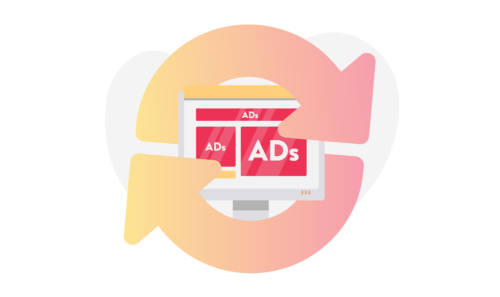How to Balance Display Ad Formats and User Experience: Dos & Don’ts
Adblocking technologies have changed the industry’s approach to online advertising. For many ad formats, their time has passed. As user awareness and possibilities have increased, dubious or annoying ads have been understood to drive traffic away and degrade a website’s value.
Why UX is so important in Website Monetization?
Users visit a website to perform a certain task, whether it is to find some information, read an article or communicate with other users. When we extend the time, or put some obstacles in their way, there is a possibility that some of these users will find other platforms to interact with.
This can lead to a drop in metrics like Pageviews, Pageviews per Session and Session Duration which will have a negative impact on the revenue. Recompensating for loss in traffic with an extended amount of ads will only accelerate loss of user traffic; and winning these users back may prove difficult.
How to identify that display ads formats are impacting User Experience?
When introducing new formats to your website, the most important thing to remember is that changes in user behavior take place over time; and shifts won’t be apparent overnight. Therefore, it is recommended to analyze data in weekly intervals; which will give you a clearer picture of the trend.
From the Better Ads study, we know how certain ad formats are received. Implementing this knowledge directly on the website will give you an overall idea of how users might rate it.
Another way of approaching this is by using Ad Experience report from Google Search Console, which will return all standard violations. A high number of intrusive ads should be a trigger for changes.
Another reason for taking a closer look at UX can be the high bounce rate, which is when a single-page user leaves without taking any further actions. For some websites, this can be caused by the type of content or the way in which the traffic is being acquired (social, display ads etc.).
What is the right ad-to-content ratio for desktop and mobile?
Aside from ad formats, the first thing to attend to when it comes to UX optimization is to calculate ad-to-content ratio, separately for Desktop and Mobile.
For Desktop the limits are up to 35% multi-column and 25% single-column ad density. For Mobile the rules are stricter as ads cannot take more than 30% of the vertical height of the page (counting only main content without headers, navigation etc).
Once we got that sorted out, there is another very important thing – ads visible in a single viewport. We do not want a situation where the amount of ads exceeds the amount of content, as this brings no value to the user. Another thing that might not be well known is that it’s against Google policy to push content below the fold with ads.
Are the best practices sufficient to generate the highest possible ad revenues?
The specificity of each website is different, so relying solely on protips will make your website monetization optimal – but not necessarily the highest possible. If you want to boost your ad revenues more, and you lack resources to explore the in-depth secrets of User Experience and ad layout trends on your own, you may be interested in a tailor-made Ad Stack Review report – with Website Review being one of its chapters.

Ad Stack Review is a detailed report and an on-line workshop, explaining the current situation of your Ad Stack, pointing to what works well and what should be fixed or replaced by another solution.
Best practices for improving User Experience with Display Ad Formats: Dos
Most of the websites follow a scheme not only when it comes to placing elements like navigation or logo; but for ads as well. This allows users to become accustomed to searching for ads, and expecting to find them in the same places despite the different URLs.
It is worth following patterns like this, because it will facilitate the prediction of user behavior – where their attention is focused, and how much content they might see etc.
Combining what we know from Better Ads Standards and hundreds, if not thousands Ad Stack Reviews conducted for the Publishers, we can specify a set of guidelines.
Best Practices for Desktop:
- Save right column for skyscraper ads – either sticky or static, in better ads research whether it is rated as the most user-friendly ad format.
- Place the banner at the top of the page – the so-called top banner, the second user-friendly ad format. Its size must be adjusted to the website’s layout, as it must not push entire content below the fold. To improve its viewability it may be partially sticky.
- Use the static inline ad – ads that cross the content should be rather low in height, and they should not interfere with the user’s action.
- Sticky ad at the bottom – so-called anchor. With this ad we are approaching from being user-friendly to neutral, but it still can be considered as good practice.
Best Practices for mobile:
- Top sticky ad 320×50 – rated as the most user-friendly for mobile, can be expanded to 320×100 px.
- Sticky ad on bottom – rated as the second most user-friendly.
- Inline ads in small sizes.
- Banner at the top of the page – with 320×100 px preferred size.
Best practices for improving User Experience with Display Ad Formats: Don’ts
As mentioned already, the one of the biggest crimes against UX is the presence of excess ads. But there are a couple of more ad formats that might give rise to Adblock’s technological penalty.
- On the top of the list for both Desktop and Mobile lies Pop up ad. According to research, more than half of users would not revisit a website with these kinds of ads.
That includes Prestitial ad with/without a countdown, which appears before the content has loaded. Although its popularity passed many years ago, it still can be seen here and there – mostly as a lightbox ad, with the background partially visible, proposing signing for subscription or premium content.
- A second unwelcome ad format is video auto-play ad with sound on.
This type of ad will produce sound with no user interaction, causing a distraction and almost compelling the user to quit the tab or website. Generally, this type of ad is only allowed if some certain conditions are met: the user has interacted with the website, has added it to the home screen or its Media Engagement Index has been thresholded but it is not recommended nevertheless.
- Another point on the list consists of large anchor ads that stick to the bottom of the screen. Large means that they cover more than 30% of the area of the viewport. They limit access to content, which is especially bothersome on mobile devices.
Summing up
With Adblocking tools being widely available, User Experience must be taken into account when creating a website layout. It is worth remembering that the majority of users are not bothered by the ads themselves, only the disruptive ones.
Formats like Pop-ups, Prestitial ads, and large Anchor ads can drive users away despite the valuable content that has been created. For guidance, it is worth turning to Better Ads Standards, as their large-scale research delivers many answers in terms of the optimization of User Experience.









